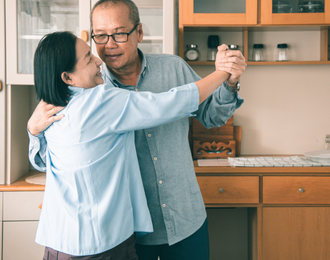Mental Health Support Groups: Pro & Cons
By Paul Wynn | February 24, 2022, Update March 17, 2022
This article is based on reporting that features expert sources.
Humans are hardwired to relate to those around them for their own well-being and sense of belonging. Mental illness can be isolating, making it challenging to connect with others. Joining a support group with others who face similar challenges can provide that important sense of support, community and kinship while also providing other important benefits like improving coping skills and enhanced self-awareness.
Mental illnesses are among the most common health conditions in the United States. More than 50% of Americans will be diagnosed with a mental illness or disorder such as depression or anxiety at some point in their lifetime. Serious mental illness like schizophrenia or bipolar disorder affects 1 in 25 Americans’ lives.
What Is a Support Group?
Support groups aim to empower people by sharing personal experiences of living and coping with a mental health condition. The groups are typically formed around a common condition – from depression or anxiety to addiction and panic disorders. Support groups often fill in a gap between what doctors provide with medical treatment and the emotional support that loved ones offer who may not understand what you’re going through.
Support groups offer a safe, supportive and non-judgmental setting where participants can be heard and gain insight and perspective about their own journey, according to Schroeder Stribling, president and CEO of Mental Health America.
Most support groups are led by people or peers who have similar personal experiences. “In peer-support group sessions, the group is led by someone who has their own lived experience with a mental health condition,” Stribling says.
There are also support groups for family members or friends of loved ones living with a mental health condition. The National Alliance on Mental Illness and other regional groups offer support groups for families and friends. “We use a loose definition of ‘family,’” says Teri Brister, chief program officer at NAMI. “If you’re the source of support for an individual with mental illness and want to learn more than about their condition, then there are specific support groups for those individuals as well.”
Support Groups: Pros & Cons
There are advantages and disadvantages to participating in support groups, including:
Pros of Support Groups
- Support groups are typically free, making them more available to a larger cross section of the population.
- Groups are normally led by those who have lived experience with the illness, which can be inspiring and comforting to those who are struggling.
- Support groups aim to share better coping skills and practical knowledge on topics such as community resources, navigating bureaucracy, specialist referrals or feedback and tips on daily management of their feelings.
- Participation is flexible so there are no firm commitments if one group doesn’t feel like a good fit. Keep looking for a support group that meets your personal and emotional needs.
Cons of Support Groups
- Speaking in front of a group about personal and private mental health challenges can be intimidating, especially for those with anxiety disorders.
- They are run on a trust-based system, so what you share is not covered by confidentiality laws.
- Currently there are no mandated training or certification for support group leaders.
- Membership participation can vary from session to session so you never know if someone familiar like an acquaintance or neighbor might show up.
Finding a Support Group
One study showed that peer-support services contribute to increases in patient engagement, positive medical outcomes, patient activation and greater use of self-management techniques. Support groups are not a substitute for care from a mental health professional, but they can be a beneficial layer of support added to existing medical care.
Look for a support group connected to an established organization that provides training to support group leaders. The National Alliance on Mental Illness and Mental Health America both offer trainings for leaders. Your doctor may also have recommendations for support groups connected to a local hospital, clinic or community center. According to Brister, “What works best are when leaders of the support group are trained and follow a structured, traditionally consistent process.”
Support Groups vs. Group Therapy: What’s the Difference?
Group therapy is led by mental health practitioners such as a psychologist who leads a group discussion and provides psychotherapy with three to 15 people during a therapy session. Group therapy sessions usually meet once a week or twice a month for about one hour. The goal of group therapy is to help members identify and address patterns of behavior with the goal of bringing about positive life changes.
Support groups and group therapy are not meant for those who find themselves in a crisis situation like a psychotic break or having thoughts of suicide.
Certain mental health conditions respond better to group therapy, says Gary Burlingame, professor and chair of psychology at Brigham Young University and president-elect of the American Group Psychotherapy Association. “When active group treatment is compared to untreated controls, large and significant improvement is produced with patients diagnosed with depression and common anxiety disorders. Some disorders are only compared to treatment as usual because of the severity of symptoms and ethical concerns in withholding treatment. Small to moderate improvement can be found in patients diagnosed with bipolar, schizophrenia and borderline personality disorder.”
As group therapy requires a different skill set than one-on-one therapy, look for a therapist certified by the American Board of Professional Psychology or the International Board for the Certification of Group Psychotherapists.
Is Online Support Worth Considering?
One of the great benefits to online groups is the convenient access they provide to those who would not necessarily have the ability to join in person, like those homebound with mental illnesses such as agoraphobia or severe depression, and those living in rural areas where groups may not be available.
COVID-19 put a hard stop to in-person support group meetings and for a while, online therapy groups became the only option. Research about the effectiveness of online peer support groups is still in its early stages, but some studies indicate that this option can be effective.
The popularity of online support groups is growing, Stribling says. “Recent research by Mental Health America shows that two-thirds of those who use peer support services currently attend via online and prefer to use this method.”





